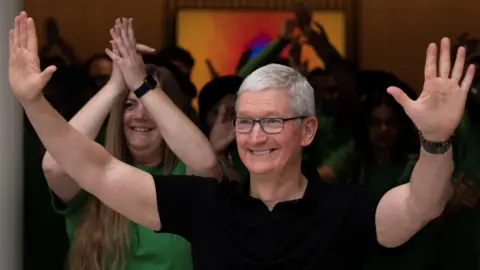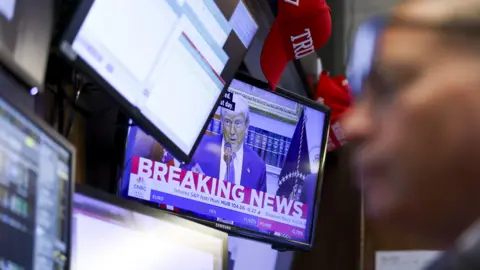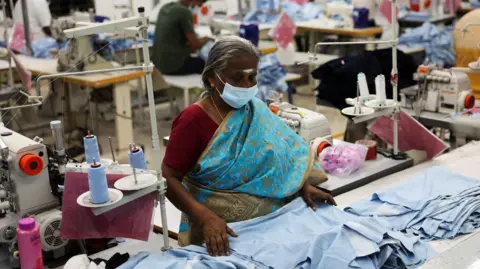United States – Will China assume India’s factory ambitions?

 Reuters
ReutersJust as India’s progress towards its long-standing dream of becoming a world factory, Washington and Beijing announced a “reset” trade that could allow Delhi to ambitiously replace China as a global manufacturing hub.
Last week, Trump’s tariffs on China fell overnight – from 145% to 30% and India’s tariffs were 27% – a deal between the two sides in Switzerland.
As a result, manufacturing investments from China to India may be “stalled” or “turned back”, leaving the Delhi-based think tank Ajay Srivastava, Global Trade Institute (GTRI).
“India’s low-cost assembly lines may survive, but the growth of value added is at risk.”
Last month, Apple said most of its iPhones were transferred from China to India.
Even President Donald Trump revealed that he told Apple CEO Tim Cook not to build in India because it is “one of the highest tariff countries in the world.”
“In the near future, India can replace China as an alternative to U.S. goods suppliers,” capital economics economist Shilan Shah wrote in an investor note before announcing the deal. He noted that 40% of India’s exports to the United States “relative to Chinese exports.”
Early signs suggest that Indian exporters have stepped in to fill the gap left by Chinese producers. New export orders soared to 14 years, according to a recent survey of Indian manufacturers.
Japanese brokerage Nomura also pointed out that India’s “anecdotal evidence” is growing, distinguishing itself from “trade transfer and supply chain transfer in low-tech manufacturing”, especially in areas such as electronics, textiles and toys.
 EPA
EPASome analysts do believe that despite the so-called “reset” trade between Beijing and Washington, the strategic decoupling between China and the United States will continue to benefit India in the long run.
First, the Narendra Modi government is more willing to open doors to foreign companies after years of protectionist policies, which may provide headwinds.
India and the United States are also negotiating a trade deal that could make Asia’s third-largest economy a best location to benefit the so-called “China Exodus” – global companies shift their businesses to diversified supply chains.
India has just signed a trade agreement with the UK, which has significantly cut responsibilities in protected sectors such as whiskey and cars. It provides a glimpse of Delhi’s concession that could be offered to Trump in the ongoing Indian-US trade negotiations.
But there is more than one reason for all this optimism.
Economists Sonal Verma and Aurodeep Nandi said in a note earlier this month that the company has not fully explained other Asian competitors, and countries such as Vietnam are on the radar.
“So, for India to take advantage of this opportunity, it needs to supplement any tariff arbitrage with serious and easy habit reforms.”
The tough business climate has long frustrated foreign investors and stagnated manufacturing growth in India, with its share of gross domestic product (GDP) for two decades.
The Modi government’s efforts, such as Production-related incentives (PLI) The solution has achieved limited success in improving this number.
Niti Aayog, the government’s think tank, has acknowledged India’s “limited success” in attracting investment transfers from China. It noted that factors such as cheaper labor, simpler tax laws, lower tariffs and proactive free trade agreements helped countries such as Vietnam, Thailand, Cambodia and Malaysia expand exports while India lags behind.
 Reuters
ReutersAnother major problem, Nomura said, is India’s continued reliance on China’s reliance on raw materials and components used in electronic products such as iPhones, limiting Delhi’s ability to make the most of its supply chain transfers.
“Revenue from making iPhones in India will only rise if more phones are made locally,” Mr Srivastava told the BBC.
According to him, Apple currently earns $450 per iPhone sold in the U.S., while India sells for less than $25, even if the entire $1,000 is considered an Indian export.
“Unless Apple and its suppliers also start making components and doing high-value work here, there are fewer iPhones in India. Otherwise, India’s share is small and exports are only increasing on paper, which could cause more scrutiny in the United States without real economic gains, without real economic gains.”
Gtri said the work of creating such assembly lines is not very high.
Mr Srivastava explained that unlike the company that established a factory in the southern city of Chennai in 2007, suppliers moved in together, “most today’s smartphone manufacturers will import parts and push for lower tariffs in India rather than building supply chains in India.” He noted that in some cases, investments made may be lower than the subsidies received by the Indian PLI program.
Ultimately, there are concerns that Chinese exporters can try to use India to re-recommend products to the United States.
Despite the pitfalls, India does not seem to object to the idea. The country’s top economic adviser said last year that the country should attract more Chinese companies to build export-oriented factories and promote its manufacturing industry – implicitly admitting that its own industrial policies have not been implemented.
But experts warn that this could further undermine India’s ability to build local knowledge and develop its own industrial base.
All of this shows that India has a long way to go besides headline announcements like Apple.
Mr Srivastava urged policy makers to urge policy makers in social media posts: “Cut down production costs, determine logistics and establish regulatory certainty.”
“Let’s be clear. This US-China reset is a damage control, not a long-term solution. India must play a long game or it’s possible to get sidelined.”
Follow BBC News India Instagram,,,,, Youtube,,,,, twitter and Facebook





